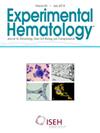Fetal heart as a new local site for hematopoiesis and macrophage formation
IF 2.1
4区 医学
Q2 HEMATOLOGY
引用次数: 0
Abstract
Cardiac tissue macrophages are crucial components of the immune system and tissue homeostasis. Traditionally, these macrophages have been classified into three primary lineages: yolk sac blood island-derived erythromyeloid progenitor (EMP), yolk sac hemogenic endothelial-derived late-EMP, and hematopoietic stem cell (HSC)-derived macrophages. These classifications have shaped our understanding of the developmental origin of macrophages in the heart. However, recent studies have significantly shifted this perspective by revealing that the heart itself possesses an intrinsic source of macrophages, independent of the traditionally recognized hematopoietic sources. This discovery has added a new dimension to our understanding of macrophage biology in the context of cardiac development. Our recent work has provided compelling evidence that endocardial cells exhibit hematopoietic potential during embryonic days (E) 8.5 to E10. This discovery challenges the previously held belief that macrophages in the heart are exclusively derived from EMP or HSC. Endocardial cells give rise to a distinct population of cardiac tissue macrophages that play vital roles in heart morphogenesis. These findings open up new avenues for understanding how macrophages contribute to heart formation, homeostasis, and their disruption. This review summarized the latest findings on the role of endocardium-derived macrophages, along with other macrophage lineages, in contributing to heart development and the maintenance of cardiac homeostasis.
胎儿心脏作为造血和巨噬细胞形成的新局部部位。
心脏组织巨噬细胞是免疫系统和组织稳态的重要组成部分。传统上,这些巨噬细胞被分为三个主要谱系:卵黄囊血岛源性红髓祖细胞(EMP)、卵黄囊造血内皮源性晚期EMP和造血干细胞(HSC)源性巨噬细胞。这些分类塑造了我们对心脏巨噬细胞发育起源的理解。然而,最近的研究已经显著地改变了这一观点,揭示了心脏本身具有一个内在的巨噬细胞来源,独立于传统认识的造血来源。这一发现为我们对巨噬细胞生物学在心脏发育过程中的理解增加了一个新的维度。我们最近的工作提供了令人信服的证据,证明心内膜细胞在胚胎期(E)8.5至E10期间表现出造血潜能。这一发现挑战了先前认为心脏中的巨噬细胞仅来自EMP或HSC的观点。心内膜细胞产生独特的心脏组织巨噬细胞群,在心脏形态发生中起重要作用。这些发现为理解巨噬细胞如何促进心脏形成、体内平衡及其破坏开辟了新的途径。本文综述了心内膜源性巨噬细胞以及其他巨噬细胞谱系在促进心脏发育和维持心脏稳态中的作用的最新发现。
本文章由计算机程序翻译,如有差异,请以英文原文为准。
求助全文
约1分钟内获得全文
求助全文
来源期刊

Experimental hematology
医学-血液学
CiteScore
5.30
自引率
0.00%
发文量
84
审稿时长
58 days
期刊介绍:
Experimental Hematology publishes new findings, methodologies, reviews and perspectives in all areas of hematology and immune cell formation on a monthly basis that may include Special Issues on particular topics of current interest. The overall goal is to report new insights into how normal blood cells are produced, how their production is normally regulated, mechanisms that contribute to hematological diseases and new approaches to their treatment. Specific topics may include relevant developmental and aging processes, stem cell biology, analyses of intrinsic and extrinsic regulatory mechanisms, in vitro behavior of primary cells, clonal tracking, molecular and omics analyses, metabolism, epigenetics, bioengineering approaches, studies in model organisms, novel clinical observations, transplantation biology and new therapeutic avenues.
 求助内容:
求助内容: 应助结果提醒方式:
应助结果提醒方式:


